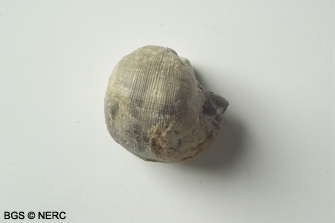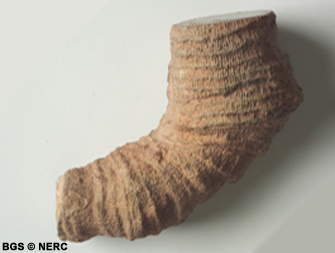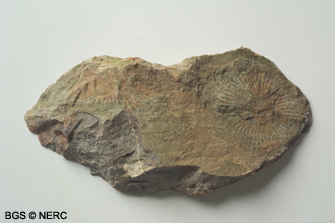
The fossils of Mendip
Silurian | Upper Devonian | Lower Carboniferous | Triassic | Lower to Middle Jurassic
Lower Carboniferous fossils (359 to 326 million years ago)
Avon Group (Lower Limestone Shale)
The lowest part of the Avon Group has a rather restricted fauna that includes the brachiopod Lingula, gastropods, bivalves and fish, suggesting that fully marine conditions were not immediately established across the Mendips in the early Carboniferous. The main fauna of the Avon Group is brachiopod-dominated, and species of Chonetes, Productus, Eumetria, Camarotechia and Unispirifer are common.
Crinoid stem fragments locally occur in rock-building proportions, forming the iron-stained crinoidal limestones that occur in the succession, and bryozoans form the well-known 'Bryozoa Bed' in the lower part of the group.
Black Rock Limestone Subgroup
The Black Rock Limestone is the most fossiliferous part of the Carboniferous Limestone in the Mendips. The remains of crinoids, brachiopods and corals are especially abundant, and three broad faunal subdivisions can be recognised. In the lowest subdivision brachiopods are dominant, such as Cleiothyridina, Dictyoclostus, Pugilis, Rhipidomella, Rugosochonetes and Syringothyris.
This interval is similar to the fauna of the Avon Group, but can be distinguished by the presence of the coral Zaphrentites delanouei and the brachiopod Rugosochonetes vaughani. The middle part of the Black Rock Limestone is characterised by a rich coral fauna, particularly Caninophyllum, Caninia, Cyathaxonia, Cyathoclisia, Fasciculophyllum and Sychnoelasma.
In the upper part of the Black Rock Limestone the coral Siphonophyllia cylindrica is diagnostic and brachiopods, such as Pustula cf. pustuliformis, become an increasingly important part of the fauna.

Burrington Oolite Subgroup and Vallis Limestone Formation
Crinoid remains are an important constituent of much of the lower part of the Burrington Oolite, and especially of the coarse bioclastic limestones that form the laterally equivalent Vallis Vale Limestone Formation. In the Burrington Oolite, the coral Palaeosmilia murchisoni occurs in the lower part of the formation and Siphonodendron ['Lithostrotion'] martini in the upper part. The brachiopod fauna includes Gigantoproductus, Delepinea, and Megachonetes, the latter two mainly occurring in the lower part of the formation; Davidsonina occurs near the top. The coral and brachiopod fauna of the Vallis Vale Limestone in the Mendips is similar to that occurring in the Burrington Oolite, including Palaeosmilia murchisoni and Delepinea.

Clifton Down Limestone Formation
The Clifton Down Limestone has a rich but low diversity fauna. The most notable feature is the abundant, partly silicified remains of the coral Siphonodendron ['Lithostrotion'] martini in the middle part of the formation. This coral-rich interval, named the 'Lithostrotion Beds', forms a conspicuous marker-interval that can be traced across the Mendip region. Axophyllum 'Carcinophyllum' vaughani is another widely occurring coral in this unit, and the brachiopod fauna includes Composita, which are concentrated at horizons throughout the formation. Megachonetes and Linoprotonia also occur, and Davidsonina is common in the lower part of the Clifton Down Limestone.
Oxwich Head Limestone Formation
A rich fauna of crinoids, corals and thick-shelled brachiopods is characteristic of the Oxwich Head Limestone, the top of which also contains goniatites and a diverse gastropod fauna, indicating full open-marine conditions. There is a distinct change in the coral and brachiopod fauna compared to the underlying Clifton Down Limestone; although species of Lithostrotion continue to occur, several species of Dibunophyllum are also present, and the brachiopods include the large Gigantoproductus maximus, as well as spiriferoids, athyroids and chonetoids.

- Home
- Overview maps
- Locality
areas
- Cheddar Gorge
- Charterhouse
- Blackdown
- Burrington Combe
- Shipham & Rowberrow
- Crook Peak & Axbridge
- Banwell to Churchill
- Priddy
- Harptree & Smitham Hill
- Draycott & Westbury-sub-Mendip
- Wookey Hole & Ebbor Gorge
- Wells
- Great Elm & Vallis Vale
- Mells & the Wadbury Valley
- The Vobster area
- The Whatley area
- Torr Works & Asham Wood
- Beacon Hill
- Stoke St Michael & Oakhill
- Holwell & Nunney
- Shepton Mallet & Maesbury
- Gurney Slade & Emborough
- The Nettlebridge valley
- Geology
- Minerals and mines
- Quarrying
- Caves and karst
- Biodiversity
- Detailed site information
- Acknowledgements
- External links
- Search
- Site map